Wound Care Guide: Essential Tips for Effective Healing
Wound care is an important part of medical practice, requiring the application of specialized knowledge and skills. It involves a range of medical treatments to successfully manage and treat wounds, from small cuts and scrapes to more serious lacerations, burns, chronic ulcers, and bite wounds. Wound care professionals must consider various factors such as wound type, size/depth, location on the body, healing progress, underlying medical conditions in order to determine the best course of action for each individual patient. The goal of proper wound care is to ensure timely healing with minimal scarring and limited risk of infection. This includes the use of dressings that absorb fluids, control temperature, provide protection against bacteria and provide cushioning for the wound area. Additionally, wound care can include surgical procedures such as debridement or skin grafting. Taking good care of a wound is essential for it to heal quickly and properly; this requires a concerted effort between patient and provider. Please keep reading for details on the following topics:
Causes of wounds
Types of wounds
How a wound heals
Factors which interfere with wound healing
Purpose of caring for a wound
How to care for a wound
Burns
Signs of infection
When to seek urgent medical care
Signs of infection
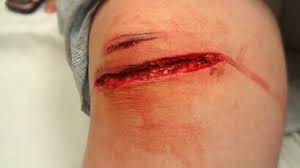
Wound
A wound is a break or damage, or any type of physical injury to the body that has been caused by a traumatic event. This can include cuts, scrapes, puncture wounds, burns and bruises. Wounds can range from minor to severe in terms of their severity. Depending on the level of damage, they can require medical attention or be treated with over-the-counter medications. Wound healing is a complex process involving multiple factors such as tissue repair, inflammation and immunity. It involves the migration of cells to the wound site, secretion of inflammatory cytokines and angiogenesis (formation of new blood vessels). The healing process also includes infection control, nutritional support and pain management. Depending on the cause and nature of the wound, proper care and treatment is essential for successful healing.
Causes of wounds
Here are some common causes of wounds:
- Cuts and lacerations: Sharp objects like knives, glass, or tools can cause cuts or lacerations to the skin. These wounds may vary in severity depending on the depth and location.
- Burns: Exposure to heat, flames, hot liquids, chemicals, or electricity can result in burn injuries. Burns can cause damage to the skin and underlying tissues, ranging from mild to severe.
- Puncture wounds: Sharp objects such as nails, needles, or animal bites can puncture the skin, leading to puncture wounds. These wounds may penetrate deep into the tissue and carry a risk of infection.
- Pressure ulcers: Also known as bedsores or pressure sores, pressure ulcers develop when prolonged pressure on the skin restricts blood flow, leading to tissue damage. They often occur in individuals who are bedridden or wheelchair-bound.
- Surgical incisions: Incisions made during surgical procedures can result in wounds. These wounds are typically intentional and are closed with sutures or staples after the surgery.
- Trauma: Accidents, falls, sports injuries, or physical altercations can cause traumatic injuries, such as bruises, abrasions, or fractures, which may result in wounds.
- Ulcers: Ulcers are open sores that develop on the skin or mucous membranes due to various factors, including poor circulation, pressure, infection, or underlying medical conditions like diabetes or vascular disease.
- Skin tears: Skin tears are common in older adults and occur when the skin is fragile and tears easily, often due to minor trauma or shearing forces.
- Medical conditions: Certain medical conditions, such as diabetes, peripheral artery disease, or autoimmune disorders, can impair wound healing and increase the risk of developing wounds or ulcers.
- Infections: Bacterial, viral, or fungal infections can lead to skin lesions, abscesses, or open wounds. These infections may result from poor wound care, compromised immune function, or exposure to infectious agents.
-
Foreign bodies: Objects or debris embedded in the skin, such as splinters, glass shards, or metal fragments, can cause wounds and increase the risk of infection if not promptly removed.
Types of wounds
Types of wounds vary based on the cause, severity, and affected tissue layers. Here are some common types:
- Superficial wounds and abrasions:
- Affect the skin surface without penetrating deeper layers.
- Caused by friction against a surface or object.
- Examples include minor cuts, scrapes, or grazes.
- Deep abrasions:
- Involve damage to all layers of the skin.
- Typically result from more forceful trauma.
- May require medical attention and sutures to close the wound.
- Puncture wounds:
- Caused by sharp, pointed objects penetrating the skin.
- Examples include needle sticks, nail pricks, or stab wounds.
- Prone to infection due to the depth and narrowness of the wound.
- Bite wounds:
- Result from human or animal bites.
- Can lead to significant tissue damage and infection.
- Prompt medical attention is necessary to prevent complications.
-
Pressure sores (Bedsores):
- Also known as bedsores or pressure ulcers.
- Develop due to prolonged pressure on the skin, often in bedridden or immobile individuals.
- Areas most affected include bony prominences like the hips, heels, and tailbone.
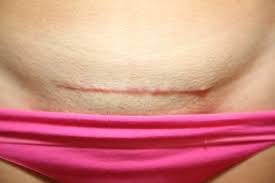
How a wound heals
The process of wound healing involves several stages, each playing a crucial role in restoring the damaged tissue to its original state. Here’s an explanation of how a wound heals:
- Inflammatory stage:
- The initial response to injury involves inflammation, characterized by the release of chemical signals and the activation of immune cells.
- Blood vessels in the affected area constrict to minimize bleeding, followed by dilation to increase blood flow, delivering oxygen and nutrients to the wound site.
- Platelets in the blood form a clot to stop bleeding, while white blood cells (leukocytes) migrate to the wound to combat infection and remove debris.
- Proliferative (fibroblastic) stage:
- During this stage, fibroblasts, specialized cells responsible for collagen production, migrate to the wound site and begin to lay down new connective tissue.
- Granulation tissue, composed of new blood vessels and collagen, forms to fill in the wound bed and promote tissue regeneration.
- Epithelial cells at the wound edges proliferate and migrate over the granulation tissue, resurfacing the wound with new skin.
-
Maturation (remodeling) stage:
- Collagen fibers laid down during the proliferative stage undergo remodeling, becoming more organized and aligned to strengthen the wound.
- Excess granulation tissue is gradually replaced by scar tissue, which may initially appear red and raised but eventually fades and flattens over time.
- The wound contracts as myofibroblasts pull the wound edges together, reducing its size and promoting closure.
Factors that interfere with wound healing
Several factors can interfere with the normal wound healing process, potentially delaying or impairing tissue repair. These factors can range from local conditions at the wound site to systemic issues affecting the entire body. Here are some common factors that can interfere with wound healing:
- Infection: Bacterial, fungal, or viral infections can significantly impede wound healing by prolonging the inflammatory phase, promoting tissue damage, and hindering the formation of granulation tissue.
- Poor blood supply (Ischemia): Adequate blood flow is essential for delivering oxygen, nutrients, and immune cells to the wound site. Conditions that reduce blood flow, such as peripheral vascular disease or atherosclerosis, can compromise tissue oxygenation and impair healing. Varicose veins can restrict blood flow and cause swelling, leading to skin breakdown and ulcers, which can interfere with wound healing.
- Chronic diseases: Certain chronic health conditions, such as diabetes, hypertension, autoimmune disorders, and vascular diseases, can impair the body’s ability to heal wounds by interfering with immune function, blood circulation, oxygenation, nutrient delivery and tissue repair processes.
- Malnutrition: Inadequate intake of essential nutrients, including protein, vitamins (e.g., vitamin C, vitamin A, and zinc), and minerals, can compromise the body’s ability to generate new tissue, synthesize collagen, and fight infection, leading to delayed wound healing.
- Age: Advanced age is associated with a decline in the body’s regenerative capacity, immune function, and tissue repair mechanisms, resulting in slower wound healing and increased susceptibility to complications.
- Medications: Certain medications, such as corticosteroids, immunosuppressants, nonsteroidal anti-inflammatory drugs (NSAIDs), and chemotherapy agents, can interfere with wound healing by suppressing immune function, impairing collagen synthesis, or causing adverse effects on blood vessels.
- Smoking: Tobacco smoke contains numerous toxic chemicals that can impair wound healing by reducing blood flow, oxygen delivery, and collagen synthesis, as well as promoting inflammation and oxidative stress.
- Obesity: Excess body weight and adipose tissue can impair wound healing by increasing mechanical stress on the wound site, promoting inflammation, and disrupting the formation of new blood vessels and granulation tissue.
- Excessive wound tension: Wounds subjected to excessive tension, such as surgical incisions under high mechanical stress or wounds located over joints or bony prominences, may experience delayed healing, increased scar formation, or wound dehiscence (splitting open).
- Foreign bodies and debris: Presence of foreign bodies, necrotic tissue, or debris within the wound can promote inflammation, infection, and delayed wound healing by hindering the migration of cells, impairing tissue regeneration, and providing a favorable environment for microbial growth.
- Dead skin and foreign materials: Presence of dead tissue or foreign objects within the wound can impede healing by hindering cell migration and tissue regeneration. Dry skin can also impede wound healing by creating an unfavorable environment for cell migration and proliferation. Maintaining a moist wound environment is crucial for optimal healing.
- Persistent bleeding: Continuous bleeding prevents the wound edges from coming together, impairing the formation of new tissue and delaying healing.
- Immobility: Prolonged immobility increases the risk of developing pressure ulcers (bedsores) due to constant pressure and friction on the skin, leading to tissue damage and delayed healing.
Purpose of caring for a wound
-
Reduce pain: Proper wound care aims to alleviate discomfort associated with the injury by minimizing inflammation, controlling infection, and providing adequate pain management.
- Prevent infection: Wound care protocols focus on reducing the risk of infection by keeping the wound clean, removing debris and foreign material, and applying antimicrobial agents when necessary.
- Promote healing: The primary goal of wound care is to facilitate the natural healing process by creating an optimal environment for tissue repair and regeneration. This involves protecting the wound, promoting angiogenesis (formation of new blood vessels), and stimulating the production of granulation tissue.
- Restore function: Depending on the location and severity of the wound, effective wound care strategies aim to restore normal function and mobility to the affected area by promoting tissue regeneration and minimizing scar formation.
- Prevent complications: Comprehensive wound care protocols aim to prevent complications such as excessive bleeding, delayed healing, tissue necrosis, and secondary infections, which can prolong recovery time and lead to more serious health issues.
- Minimize scarring: By promoting optimal wound healing and minimizing tissue damage, wound care efforts aim to reduce the risk of excessive scarring and promote cosmetically favorable outcomes.
- Provide comfort and support: Wound care interventions should address the psychological and emotional needs of the patient by providing comfort measures, emotional support, and clear communication throughout the healing process.
-
Educate and empower: Effective wound care involves educating patients and caregivers about proper wound management techniques, signs of infection, and strategies for preventing future injuries. Empowering individuals with knowledge and skills enables them to actively participate in their own care and promotes better outcomes.
How to care for a wound
Caring for a wound involves several key steps to promote healing and prevent complications. Here’s a general guide on how to care for a wound:
- Stop the bleeding: Apply gentle pressure with a clean cloth or sterile gauze to control any bleeding. Elevate the wound if possible, to help reduce blood flow.
- Clean the wound: Gently rinse the wound with clean water to remove dirt, debris, and bacteria. Avoid using soap, hydrogen peroxide, or alcohol, as these can irritate the wound and slow down healing.
- Apply an antiseptic: If the wound is dirty or at risk of infection, apply a mild antiseptic solution, such as povidone-iodine or chlorhexidine, to the surrounding skin. Avoid getting antiseptic directly into the wound.
- Protect the wound: Cover the wound with a sterile dressing or adhesive bandage to keep it clean and prevent further injury. Change the dressing regularly, at least once a day or whenever it becomes wet or soiled.
- Promote healing: Depending on the type and severity of the wound, you may need to apply an over-the-counter antibiotic ointment to help prevent infection and promote healing. Follow the instructions on the product label.
- Monitor for signs of infection: Keep an eye on the wound for any signs of infection, such as increased redness, swelling, warmth, or pus drainage. Seek medical attention if you notice any signs of infection or if the wound doesn’t seem to be healing properly.
- Keep the wound moist: In general, keeping the wound moist can help promote faster healing. Consider using a hydrogel or moist wound dressing to create a moist environment conducive to healing.
- Protect the wound from further injury: Avoid activities that could reopen or aggravate the wound, such as excessive movement or contact with dirty or abrasive surfaces. If necessary, use protective bandages or dressings to shield the wound.
-
Follow up with a healthcare provider: If the wound is deep, large, or doesn’t seem to be healing properly, or if you’re unsure about how to care for the wound, consult with a healthcare provider for further evaluation and treatment.
Burns
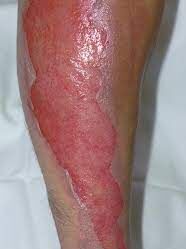
Burns are a form of severe skin trauma that can cause significant pain and tissue damage. Burns occur when the skin is exposed to intense heat, electricity, chemicals, or radiation. Depending on the severity of the burn, the affected area may vary from redness and inflammation to blistering and charring of the skin. In extreme cases, deep burns can lead to infection and permanent scarring of the area. Burn victims often require immediate medical attention in order to reduce their risk for infection and further damage. Furthermore, burns may sometimes cause nerve damage which can lead to permanent loss of sensation in the affected area. With proper treatment, however, many burn victims are able to make a full recovery with minimal scarring.
When it comes to treating burns, especially minor ones, there are several handy tips to follow to promote healing and alleviate discomfort:
- Cool the burn: Immediately after sustaining a burn, run cool (not cold) water over the affected area for several minutes. This helps to cool the skin and alleviate pain. Avoid using ice, as it can further damage the skin.
- Remove tight clothing or jewelry: If the burn occurs on an area covered by clothing or jewelry, gently remove them to prevent further irritation or restriction of blood flow.
- Apply a cool compress: After cooling the burn with water, apply a clean, damp cloth or sterile gauze to the affected area. This can help soothe the skin and reduce inflammation.
- Protect the burn: Cover the burn with a sterile, non-adhesive bandage or clean cloth to protect it from further injury and reduce the risk of infection. Avoid applying any ointments, creams, or butter to the burn, as these can trap heat and promote infection.
- Take over-the-counter pain relievers: If necessary, you can take over-the-counter pain relievers such as ibuprofen (Advil, Motrin) or acetaminophen (Tylenol) to help alleviate pain and reduce inflammation. Follow the dosage instructions carefully.
- Avoid popping blisters: If blisters form as a result of the burn, do not pop them. Popping blisters can increase the risk of infection and slow down the healing process. Instead, leave the blisters intact and allow them to heal on their own.
- Keep the burn clean and dry: To prevent infection, keep the burn clean and dry. Wash your hands thoroughly before touching the burn, and avoid exposing it to dirt, chemicals, or other contaminants.
-
Seek medical attention if necessary: If the burn is severe, covers a large area of the body, or is located on the face, hands, feet, or genital area, seek medical attention immediately. Additionally, seek medical attention if the burn becomes infected, is accompanied by fever, or does not improve within a few days.
Ulcer
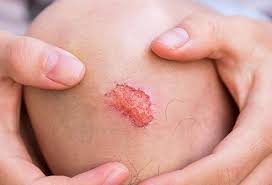
An ulcer is characterized by the presence of an open sore or lesion on the skin or mucous membrane that fails to heal properly, often resulting from trauma, pressure, infection, or circulatory problems. These wounds typically present as open sores or lesions and may be accompanied by inflammation, pain, and drainage.
Signs of infection
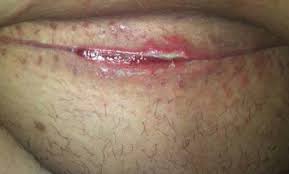
Signs of infection in a wound can vary depending on the severity and type of infection. Here are common signs and symptoms to watch out for:
- Redness to the skin: The skin around the wound may appear reddened or inflamed, indicating an inflammatory response to infection.
- Swelling to the skin around the wound: Infection can cause localized swelling or edema, resulting in increased tissue volume and tenderness.
- Green or yellow discharge from the wound: Purulent or discolored discharge, often green or yellow in color, may indicate the presence of pus and bacterial infection in the wound.
- Swelling to the wound: The wound itself may appear swollen or puffy due to inflammation and fluid accumulation within the tissues.
- Presence of lymph nodes to the neck, armpit, or groin: Enlarged or tender lymph nodes near the wound site may indicate a systemic immune response to infection.
- Increase in warmth and tenderness around the wound: The affected area may feel warmer than usual to the touch and become increasingly tender or painful.
- Fever: Systemic signs of infection, such as fever, may develop as the body’s immune system responds to the invading pathogens.
- Chills: Cold chills or shivering episodes may accompany fever as the body attempts to regulate its temperature in response to infection.
Wound treatment
In order to assess and manage a wound effectively, various tests and interventions may be conducted. Here is a breakdown of the procedures and treatments involved:
- X-ray: X-rays may be performed to evaluate the extent of underlying bone or soft tissue damage associated with the wound, particularly in cases of penetrating trauma or suspected fractures.
- Ultrasound scan: Ultrasound imaging may be utilized to assess soft tissue injuries, identify fluid collections or abscesses, and evaluate blood flow to the affected area.
- Physical examination: A thorough physical examination of the wound and surrounding structures will be conducted to assess the extent of tissue damage, presence of foreign bodies, and involvement of nerves or blood vessels.
- Medical history: Gathering information about the patient’s medical history, including chronic conditions, recent surgeries, and medication use, helps identify potential risk factors for delayed wound healing or complications.
- Blood and urine tests: Laboratory tests may be ordered to evaluate the patient’s overall health status, assess for signs of infection or systemic inflammation, and screen for underlying medical conditions that may affect wound healing.
- Biopsy: A tissue biopsy may be performed to obtain a sample of the wound for microscopic examination, allowing for identification of specific pathogens, assessment of tissue viability, and determination of appropriate treatment strategies.
- Wound culture: Cultures of the wound site may be collected to identify the presence of pathogenic microorganisms, guide antibiotic selection, and monitor response to treatment.
- Suturing: Fresh wounds less than 12 hours old may be closed with sutures (stitches) to promote wound approximation and facilitate primary intention healing. Older wounds may require alternative closure methods or delayed closure based on clinical judgment.
- Irrigation: The wound will be thoroughly irrigated with a sterile saline solution or antiseptic solution to remove debris, contaminants, and foreign objects, reducing the risk of infection and promoting wound cleanliness.
- Tetanus vaccination: Depending on the patient’s vaccination history and the nature of the wound, a tetanus booster may be administered to prevent tetanus infection, especially in cases of contaminated or puncture wounds.
- Exploratory surgery: Deep or complex wounds may require surgical exploration in the operating room to assess internal structures, address underlying injuries, and ensure adequate wound debridement and closure.
- Debridement: Dead or necrotic tissue within the wound may be surgically removed (debrided) to promote wound healing, prevent infection, and facilitate the formation of healthy granulation tissue.
- Closure: Large wounds or surgical incisions may be closed with sutures, staples, tissue adhesives, or skin grafts to optimize wound healing and minimize scarring.
- Dressing: The wound may be dressed with appropriate wound care products, such as sterile gauze, adhesive dressings, hydrocolloids, or antimicrobial ointments, to provide protection, moisture balance, and optimal healing conditions.
-
Medication: Pain relievers, antibiotics, anti-inflammatory drugs, and other medications may be prescribed to manage pain, prevent or treat infection, and support wound healing.
When to seek urgent medical care
It is important to know when to seek urgent medical care, as delaying appropriate treatment can lead to further health complications. If you experience any of the following symptoms, you should seek medical help immediately. If you have any doubts about whether you should seek medical care, it is always better to err on the side of caution and consult with your doctor.
Wounds that require intervention by a healthcare professional
- Wound will not stop bleeding even after pressure was applied: Persistent bleeding from the wound site despite adequate pressure may indicate underlying vascular injury or impaired clotting mechanisms.
- Wound appears very deep and wide: Deep, gaping wounds with irregular edges may be more prone to infection and delayed healing due to increased exposure to pathogens and compromised tissue integrity.
- Wound is located near the eye: Wounds near sensitive areas like the eyes or mucous membranes are at higher risk of infection and potential complications, requiring prompt evaluation and treatment.
- Wound is gaping: Wounds that fail to approximate or close properly may be at increased risk of contamination and infection, particularly if left untreated.
- Wound was caused by a dirty or rusty object: Wounds contaminated with dirt, debris, or rust may introduce harmful bacteria or foreign particles, increasing the risk of infection.
- The presence of dirt or other object in the wound: Visible debris or foreign material embedded in the wound should be removed promptly to prevent infection and promote healing.
- Wound is very painful: Excessive pain, especially beyond the expected level of discomfort associated with wound healing, may indicate infection, nerve involvement, or tissue damage.
- Wound was caused by a bite from a human being or animal: Animal or human bites carry a high risk of infection due to the introduction of bacteria from the oral cavity or skin flora, requiring immediate medical attention and potential prophylactic antibiotic therapy.
-
Have poorly controlled diabetes: Individuals with poorly controlled diabetes are more susceptible to wound infections due to impaired immune function, reduced circulation, and compromised tissue healing, necessitating vigilant monitoring and comprehensive wound care.
Disclaimer: The information provided in this content is for general informational purposes only. It is not intended as medical or healthcare advice, diagnosis, or treatment. Always seek the advice of a qualified healthcare professional with any questions you may have regarding a medical condition or healthcare decisions.

